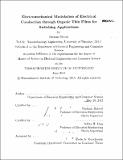Electromechanical modulation of electrical conduction through organic thin films for switching applications
Author(s)
Niroui, Farnaz
DownloadFull printable version (14.67Mb)
Other Contributors
Massachusetts Institute of Technology. Department of Electrical Engineering and Computer Science.
Advisor
Vladimir Bulović and Jeffrey H. Lang.
Terms of use
Metadata
Show full item recordAbstract
Nanoelectromechanical (NEM) switches exhibit abrupt switching behavior and near-zero leakage current making them promising alternatives to conventional semiconductor switches. However, they require high actuation voltages and commonly suffer from permanent adhesion of device components leading to failure. This thesis proposes a novel NEM switch, or "squitch", that overcomes these challenges by electromechanical modulation of tunneling current through a nanometer-thick gap defined by an organic thin-film sandwiched between two electrodes. The switching is initiated by an applied voltage compressing the organic film to reduce the tunneling width leading to an exponential increase in the tunneling current. The deformed organic material prevents direct contact of the electrodes, while also providing the restoring force necessary to turn off the switch when the electrostatic force is removed, mitigating stiction-induced failure. In this thesis, the feasibility of the proposed switching mechanism is investigated through theoretical analysis of two- and three-terminal devices, demonstrating the possibility of energy efficient operation in the sub-1 V regime, with nanoseconds switching time and a large on-off current ratio of greater than 106. Based on the theoretical studies, design requirements are identified to guide the fabrication process of the proposed devices. Various methods of fabricating these devices have been developed, the details of which are outlined in this work.
Description
Thesis (S.M.)--Massachusetts Institute of Technology, Dept. of Electrical Engineering and Computer Science, 2013. Cataloged from PDF version of thesis. Includes bibliographical references (pages 101-105).
Date issued
2013Department
Massachusetts Institute of Technology. Department of Electrical Engineering and Computer SciencePublisher
Massachusetts Institute of Technology
Keywords
Electrical Engineering and Computer Science.